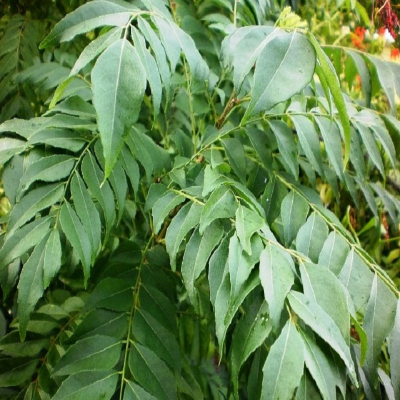Distribution and Habitat: Seen in the foot of the Himalaya and Bashahi eastwards to Sikkim and Peninsular India, upto 1700 m. It is also found in Sri Lanka, Burma, Indo-China, South China and Hainan. Commercial cultivation in India is limited to Tamil Nadu and Karnataka states.
Botany: A deciduous shrub or small tree, bark grey with shallow netted fissures; wood hard, even-grained, durable, greyish white; rachis 15-30.5 cm long, terete, pubescent.
- Leaves: Imparipinnate; leaflets 10-20, 2.5 cm long, ovate or lanceolate, oblique at base, obtusely acuminate or retuse, subentire or irregularly crenulate. Petioles 0.25 cm long, terete, pubescent.
- Flowers: White, 0.8-1.3 cm long, in terminal corymbose panicles. Calyx pubescent, sepals small, acute. Petals 6 mm long, linear-oblong, rounded at the base, gland dotted. Filaments dilated at the base. Ovary 2 celled, ovules solitary in each cell (rarely 2).
- Fruit: Berry sub globose, 0.85 cm diameter, black when ripe, 2-seeded.
Properties: The roots, bark and leaves are bitter, acrid, astringent, cooling, aromatic, demulcent, depurative, anathematic, febrifuge, stomachic, appetising, carminative, anti-inflammatory and antiseptic. Aerial part is spasmolytic and antiprotozoal. Root is antiprotozoal, CVS active and has effect on nictitating membrane. Leaf is hypoglycaemic
Chemical constituents: All parts of the plant, especially the leaves are rich in carbazole alkaloids. These include members with (i) C13 - skeleton -murrayanin, mukoeic acid, mukonine and mukonidine; (ii) C18 - skeleton including gerinimbine, koenimbine, murrayacine, koenigine and koenigicine (koenidine); and (iii) C23- skeleton containing mahanimbine, mahanimbicine, iso-mahanimbicine, mahanine, mahanimbinine, murrayayazoline, murrayazolinine, murrayazolidine, cyclomahanimbine and bicyclomahanimbicine. The leaves gave a coumarin glucoside and scopolin. Essential oil from leaves contained b-caryophylline, b-elemene, b-phellandrene, b-thujene as major constituents.
Uses: Curry leaf, a plant of homestead gardens has gained importance as a commercial crop and is cultivated for its culinary and medicinal value. The plant is highly esteemed for its leaves which promote appetite and digestion and destroy pathogenic organisms. It is reported to be useful in emaciation, pain of kidney, skin diseases, hemopathy, worm troubles, neurosis and poisons. They are useful in vitiated conditions of kapha and pitta, hyperdipna, colic, flatulence, diarrhoea, dysentery, vomiting, inflammations and foul ulcers.
Formulations: The important preparations using the drug are Kalasadi kasayam, Pamantaka tailam, Jatyadi tailam, Jatyadi ghrtam. “Kaidaryah” drug is prepared using this plant which improves voice, stimulates digestion and destroys concocted poisons in the system.
Agrotechnology
Climate and soil: Curry leaf tree does not choose a specific climate and can come up even in dry climate too. In places where minimum temperature goes below 13°C, the growth of the shoot will be slightly affected. It comes up well in light textured red soils.
Propagation: Curry leaf is propagated by seed.
Irrigation: Then long furrows are formed connecting all the pits to facilitate easy irrigation. The seedlings are irrigated once in 5-7 days upto 3 years and once in 15 days afterwards. The field should be kept free from weeds. Plants may be trained and pruned to maintain a bush of 1m in height.
Manures and Fertilizers: For better growth and yield, each plant is fertilised with 20 kg of FYM besides 150:25:50 g of N, P2O5 and K2O/ year.
Plant protection: Attack of aphids in the vegetative stage can be controlled by spraying of dimethoate at 2ml/ l of water.
Harvesting: Leaves from such sprayed plants should be harvested only after 10 days. Spraying carbendazim at 1g/ l can take care of leaf spot diseases. The crop comes to first harvest at the end of first year. The yield of leaves account to 400 kg/ha at the end of first year, 2000 to 2200 kg/ ha in the second and third year harvested at an interval of four months and 2500 kg/ ha in the fourth year harvested at three months interval. From fifth year onwards it is harvested at 2.5-3 month’s interval giving a yield of 3500-5000 kg/ ha

